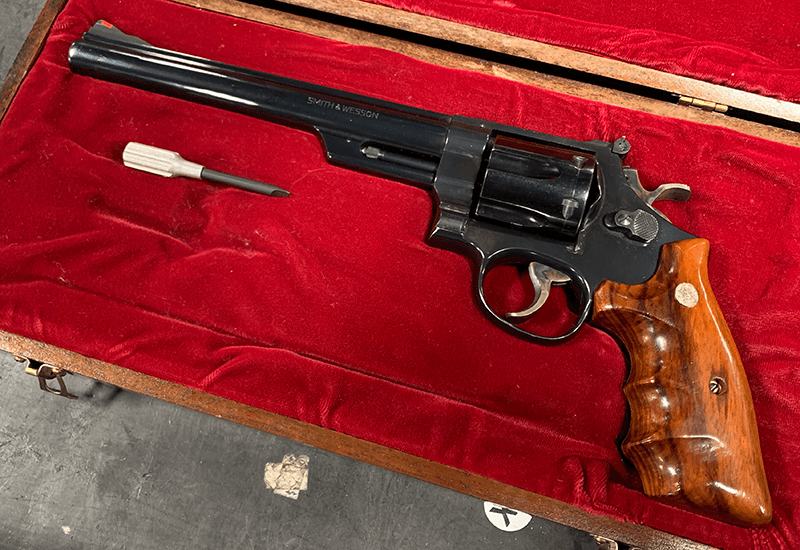The following stories were shared by email with permission to publish.
Dear Santa…
Recently, like many of you, I read an article in the news about a sanctimonious mall Santa who thought it appropriate to push his views on a little boy. Specifically, the child asked for a Nerf gun for Christmas. The Santa, even after the child’s mom clarified it was a “Nerf Gun” rather than an actual firearm, continued to press the issue and stated, “No, no guns at all”. Needless to say, the boy was in tears at Santa’s turn.
This recent escapade made me reminisce about the first handgun I received as a Christmas gift from my father in 1984 when I was 12 years old — a 6” Smith & Wesson Model 28-3. Growing up in rural eastern Kentucky and the son of a police officer, I can remember loading up in dad’s truck and making the trek all the way to Lexington to pick it out. We went to Gall’s Police Supply (which back then was much smaller than it is today) and handled a 4” Model 15 and a Model 19 before settled on the 6” Model 28. The salesman, whose business card can be seen in the photo with the factory paperwork, took the time to talk with my dad and I about the strength of that big “N” frame and I was hooked!
As most Smith & Wesson aficionados know, the Model 28 was originally released in 1954 as the “Highway Patrolman”. Built much like its sibling the Model 27, it left the factory with a matte finish and devoid of the fine checkering on the top strap and barrel rib present in the 27. Generally, it had a service trigger and hammer unless ordered with the target options of its sister gun. It also only had 4” and 6” barrel offerings rather than the plethora of lengths for the Model 27. In totality, it offered the heft, durability, accuracy and shootability of the Model 27 at a lower price point which made it extremely popular with both law enforcement officers and sportsmen.
The Model 28 was adopted by state police of Florida, New York, Texas and Washington as well as countless municipalities and sheriff’s departments in search of a rugged and dependable sidearm.
The “Highway Patrolman” became the Model 28 when Smith & Wesson consolidated the catalog into model numbers in 1957. After that, it went through three design changes with the first two coming in rapid secession. For this reason, a Model 28 “no dash” will bring a 30% premium and 28-1 is regarded as “very rare” with a “substantial premium” according to the benchmark “Standard Catalog of Smith & Wesson, 4th Edition”. Shortly after that Christmas, in 1986, Smith quietly ended production of the Model 28.
Over the years, many Smith & Wesson’s have filled my safes of all degrees of finery and caliber —including a 3.5” pre-27 and pre-19 Combat Magnum — but none can replace that old Model 28-3. Not only is it the handgun I learned to shoot accurate and fast with as a teenager, but it stands in testament to the trust and faith my father placed in me at the age of 12.
In today’s world, if one were to listen to the media or a self-righteous mall Santa, you would be led to believe by entrusting such a weapon to a “child” you would be charting a course for a troubled life. However, the truth is much different. I was brought up to have great respect for the laws that bind society together; the traditions we as Americans hold dear and a reverence for the trust one person places in another. These traits have served me well throughout life as a retired Marine Corps Master Gunnery Sergeant with over 30 years of service still seeking ways I can serve my fellow man. My wife and I also raised two contributing and productive members of society that carry the values I speak of.
So, while I can’t specifically say Smith & Wesson Model 28-3 made all that come true, I can confidently say it does symbolize well-placed trust and faith that led to a life well-lived.
R. Brandon Deskins
Master Gunnery Sergeant
USMC (Ret)
Just Walked In
Working retail part-time at a local gun store, we regularly take used guns in for consignment. Most are outdated models as customers look to replace their self-defense and competition guns, while others are simply trying to make some side cash off unwanted guns they no longer shoot, but, once in a blue moon, a gun crosses our counter that makes everyone stop and take a closer look.
This past week, as I clocked into work, a glossy brown case with gold locks set aside on the counter caught my eye. Like a kid drawn to presents under a Christmas tree, I immediately opened the case to find a large-frame revolver on a bed of red velvet. A closer look revealed it was a .41 Magnum 8” Smith & Wesson Model 57 in pretty good condition. “Oohs” and “aahs” followed as I wiped the drool from my mouth and grasped the large combat grips in my hand and looked down the long, blued barrel to the red ramped front sight. The last finger groove fell right where I’d prefer to place my last digit, but the pistol felt well-balanced in my hand.
Having handled thousands of guns, there’s always something special about picking up an older firearm — especially revolvers. Originally produced between 1964 and the year prior to my birth (1991), it may not have the same mass appeal it once did but remains a classic for those who recognize its history and simplistic beauty. A revolver for a true wheelgunner, I hope whoever takes it home adds to its 30-plus years of Wheelgun Diaries, and I selfishly hope to be the one who gets to give it away.
Joe Kriz

